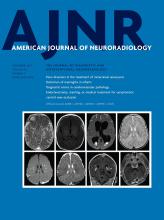Research ArticleHead & Neck
Duct-like Recess in the Infundibular Portion of Third Ventricle Craniopharyngiomas: An MRI Sign Identifying the Papillary Type
J.M. Pascual, R. Carrasco, L. Barrios and R. Prieto
American Journal of Neuroradiology September 2022, 43 (9) 1333-1340; DOI: https://doi.org/10.3174/ajnr.A7602
J.M. Pascual
aFrom the Department of Neurosurgery (J.M.P), La Princesa University Hospital, Madrid, Spain
R. Carrasco
bDepartment of Neurosurgery (R.C.), Ramón y Cajal University Hospital, Madrid, Spain
L. Barrios
cStatistics Department (L.B.), Computing Center, Spanish National Research Council, Madrid, Spain
R. Prieto
dDepartment of Neurosurgery (R.P.), Puerta de Hierro University Hospital, Madrid, Spain

References
- 1.↵
- 2.↵
- 3.↵
- 4.↵
- 5.↵
- Prieto R,
- Pascual JM,
- Barrios L
- 6.↵
- 7.↵
- 8.↵
- 9.↵
- Urbach H,
- Behrens E,
- von Deimling A, et al
- 10.↵
- Pascual JM,
- Prieto R,
- Castro-Dufourny I, et al
- 11.↵
- 12.↵
- 13.↵
- 14.↵
- 15.↵
- 16.↵
- Sartoretti-Schefer S,
- Wichmann W,
- Aguzzi A, et al
- 17.↵
- 18.↵
- 19.↵
- 20.↵
- 21.↵
- 22.↵
In this issue
American Journal of Neuroradiology
Vol. 43, Issue 9
1 Sep 2022
Advertisement
J.M. Pascual, R. Carrasco, L. Barrios, R. Prieto
Duct-like Recess in the Infundibular Portion of Third Ventricle Craniopharyngiomas: An MRI Sign Identifying the Papillary Type
American Journal of Neuroradiology Sep 2022, 43 (9) 1333-1340; DOI: 10.3174/ajnr.A7602
0 Responses
Jump to section
Related Articles
Cited By...
- No citing articles found.
This article has been cited by the following articles in journals that are participating in Crossref Cited-by Linking.
- Taro Tsukamoto, Yukio MikiJapanese Journal of Radiology 2023 41 8
- Ruth Prieto, Laura Barrios, José M. PascualNeurosurgical Review 2023 47 1
- Ruth Prieto, Tareq A Juratli, Evan D Bander, Sandro Santagata, Laura Barrios, Priscilla K Brastianos, Theodore H Schwartz, José M PascualEndocrine Reviews 2025 46 2
- Prateek Malik, Yingming Amy Chen, Benjamin Barsouma Mathew, David G. Munoz, Bernice Thamarai Selvi, Harshad Arvind Vanjare, Anitha Jasper, Pavithra Mannam, Aditya Bharatha, Shobhit MathurNeuroradiology 2024 66 6
- Le Yang, Yi Liu, ChaoHu Wang, ZhanPeng Feng, Lei Yu, Jun Pan, JunXiang Peng, Jing Nie, MingFeng Zhou, YiChao Ou, Tao Liu, Songtao Qi, Jun FanNeoplasia 2024 57
- Chandrima Biswas, Moataz D. Abouammo, Ludovica Pasquini, Guilherme Mansur, Mohammad Bilal Alsavaf, Kyle C. Wu, Ricardo L. Carrau, Daniel M. PrevedelloWorld Neurosurgery 2025 195
- Carlos González-Gallego, Pedro Molina, Cristina Hostalot, Anna Oliva, Alberto Blanco, Paloma Puyalto de Pablo, Silvia Comas, Cristina Carrato, Elena Valassi, Manel Puig-DomingoEndocrine 2025
More in this TOC Section
Similar Articles
Advertisement











